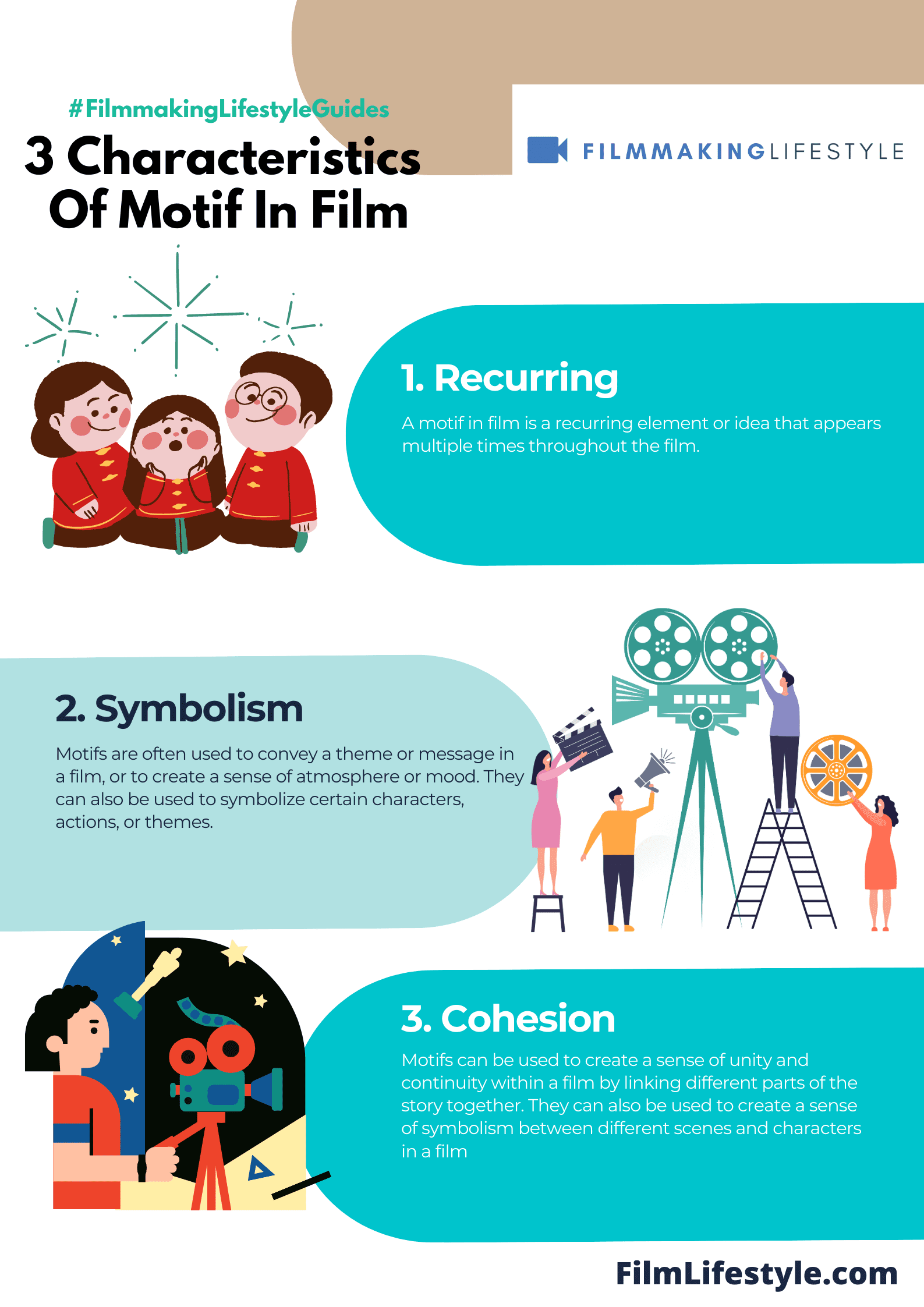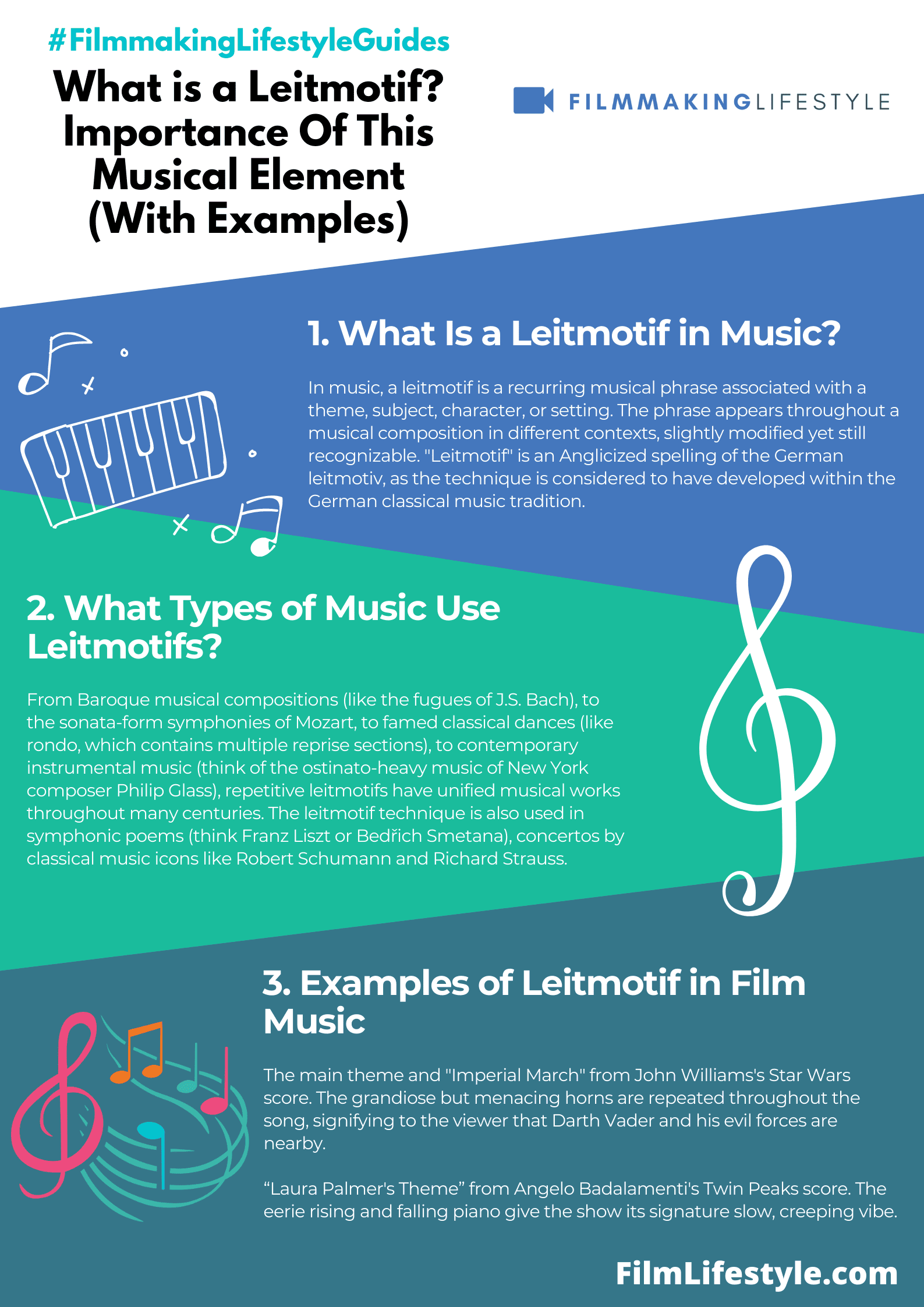Ever noticed a recurring theme that follows a character or underscores pivotal moments in a movie?
That’s a leitmotif, a powerful tool in storytelling that weaves a sonic thread throughout a film.
It’s not just in cinema either; leitmotifs are a staple in various art forms, creating connections and reinforcing themes.
Stick with us as we explore the role of leitmotifs in film and art, and how they shape our emotional responses without us even realizing it.
WHAT IS A LEITMOTIF?
What Are Leitmotifs?
Af leitmotif is a recurring theme in music. The term derives from the German word, meaning “leading motif.”
It can also be used to describe a recurring idea, symbol, or phrase that has an important role in the story you’re telling.
Leitmotifs are one of many tools authors and filmmakers use to help readers understand their films or novels by creating connections between different parts.
The presence of such patterns throughout the work provides additional depth for an audience.
What Is A Leitmotif?
In exploring the vast world of cinema, we often find the term leitmotif.
It’s a concept borrowed from classical music composition, where a short, recurring musical phrase is associated with a particular idea, character, or theme.
Leitmotifs in films operate on a similar principle, serving as aural threads woven through the tapestry of the narrative.
The use of leitmotif is not just an auditory device but a powerful storytelling tool.
Through its repetition, viewers are subtly reminded of earlier moments, and emotional connections are strengthened.
Consider the function of leitmotifs in films – they’re designed to trigger recollection, foreshadow events, or suggest character traits without a single line of dialogue.
Let’s jump into how leitmotifs manifest in films:
- A character’s presence is anticipated by their signature tune.
- Different instruments or arrangements reflect a character’s development or the evolution of a theme.
- Through subtle variations, leitmotifs can indicate changes in context or mood.
Venerated films like Star Wars and The Lord of the Rings demonstrate the leitmotif’s ability to anchor audiences to particular characters or ideas.
Every time we hear the distinct melody of the Force theme or the foreboding notes of the Ring theme, our minds unconsciously connect to the larger narrative structure they belong to.
The strength of leitmotifs lays in their flexibility.
They can be bold or understated, depending on their purpose in the film.
When used deftly, leitmotifs enhance the storytelling without overpowering it – they guide the audience’s emotional response and deepen the immersive experience that is the art of film.
The Role Of Leitmotifs In Film
Understanding the significance of leitmotifs in film requires delving into their multifaceted roles.

These recurring musical cues go beyond simply creating a memorable soundtrack.
They shape the narrative by reinforcing and mirroring the evolving dynamics within the film.
In our exploration of cinematic history, we’ve seen that leitmotifs act as emotional anchors.
They engage viewers by eliciting a conditioned response every time the motif resurfaces.
Such strategic repetition serves a vital storytelling function – it signifies character development and underscores pivotal moments.
Let’s consider the way leitmotifs convey psychological depth and signify transformations:
- Establishing a character’s psychological state,
- Evoking a sense of impending doom or foreboding,
- Communicating a shift from innocence to experience.
Films as iconic as Star Wars wield leitmotifs with exceptional expertise.
The motifs associated with characters like Darth Vader not only signal their entrance but also evoke their complex persona.
Equally important are the ways leitmotifs adapt to characters’ journey, reflecting change and growth without relying on dialogue or visual cues.
also, leitmotifs extend their reach into the realm of themes and environments.
They paint a sonic picture of locales and time periods:
- A leitmotif might embody the essence of a mystical land or a futuristic city,
- Through variations in instrumentation, they can transport the audience across cultures and epochs.
The importance of leitmotifs in building a film’s universe is undeniable.
Their carefully crafted variations act like an audio diary, mapping the journey of the narrative and its inhabitants.
Recognizing the subtleties in these motifs allows us to appreciate the composer’s role as a storyteller parallel to the director and screenwriter.
Examples Of Leitmotifs In Film
Leitmotifs in film often become synonymous with the characters or themes they represent.
For example, in Jaws, the simple yet terrifying two-note motif immediately signals the presence of the shark.
This auditory cue has embedded itself in our cultural consciousness as the embodiment of looming danger.
In the realm of fantasy, The Lord of the Rings utilizes a rich tapestry of leitmotifs to bring to life the diverse cultures and characters within its epic narrative.
Howard Shore’s score assigns distinctive themes to places like the Shire and Rivendell and characters such as the Fellowship, weaving a complex sonic narrative that enhances the storytelling.
- The Godfather – The melancholic waltz theme encapsulates the tragic essence of the Corleone family saga, lingering in the air long after a scene has ended.
- Harry Potter – “Hedwig’s Theme” serves as the magical cornerstone of the series, whisking us away to a world of wonder with every recurrence.
In Star Wars, John Williams’ masterful use of leitmotifs is not just for characters like Darth Vader but also for concepts such as the Force.
These themes are more than just repeated melodies; they’re woven into the fabric of the film’s universe, evolving with the story and taking on new meanings.
The use of leitmotifs isn’t only limited to epic sagas and thrillers, it’s also prevalent in more subdued narratives.
In Titanic, the haunting leitmotif intertwined with “My Heart Will Go On” evokes the ill-fated love story at the center of the film, painting an aural portrait that’s both romantic and sorrowful.
Recognizing these leitmotifs enriches our viewing experience, as we subconsciously begin to anticipate the emotional and narrative swings of the film.
They’re instrumental in guiding our emotions, often becoming so iconic that they transcend the movies themselves and enter the lexicon of film music legend.
Leitmotifs In Other Art Forms
While leitmotifs are prominent in film, they also play a significant role across a variety of other art forms.
In literature, for example, motifs are used to connect themes and enhance narratives.
F. Scott Fitzgerald’s The Great Gatsby employs recurring symbols like the green light and Dr. T. J. Eckleburg’s billboard that serve as leitmotifs, signaling the pursuit of the American Dream and the moral decay of society.
In opera and classical compositions, leitmotifs have deep roots.
Richard Wagner’s Der Ring des Nibelungen is renowned for its complex web of leitmotifs representing characters, places, and philosophical ideas.
This practice laid groundwork for their use in modern media, influencing countless composers and artists in the process.
Visual arts harness the power of leitmotif through symbolism and recurring elements.
Painters such as Vincent van Gogh and Salvador Dalí incorporated identifiable symbols or styles that articulate their unique vision and perspective.
Van Gogh’s swirling skies and Dalí’s melting clocks become signatures, echoing deeper themes within their bodies of work.
In the realm of video games, leitmotifs are pervasive and bolster the immersive experience.
Iconic video game series like Final Fantasy and Zelda feature recurring musical themes that evoke nostalgia and emotional connection.
Game designers and composers carefully craft these motifs to ensure a cohesive and memorable player experience.
- Video games use leitmotifs to solidify character construction.
- Recurring motifs establish thematic continuity and game identity.
We find that leitmotifs transcend the boundaries of art forms, creating a universal language of themes and emotions that resonate with audiences.
Recognition of these patterns not only enhances engagement but also deepens our appreciation for the craft behind the artistry.
By identifying these connective threads, we unlock a richer understanding of the narratives and messages woven into the very fabric of artistic expression.
How Leitmotifs Shape Emotional Responses
Leitmotifs are more than just repetitive melodies; they’re a powerful tool for emotional storytelling.
Each time a leitmotif reappears in a film, it carries with it the weight of the previous scenes, building an emotional layer that viewers might not even consciously notice.
From the ominous two-note motif in Jaws to the ethereal score of The Lord of the Rings, leitmotifs signal to the audience what to feel and expect.
The repetition of these musical phrases taps into our psychological response to familiarity and anticipation.
Consider the use of Darth Vader’s theme, known as The Imperial March in Star Wars.
Its strong, foreboding tones become inextricably linked to the character, evoking a sense of dread each time it plays.
Films are not the only medium to harness the power of leitmotifs – they’re prevalent across multiple art forms.
Here are some notable examples:
- In literature, F. Scott Fitzgerald uses leitmotifs to underscore the themes of decadence and the American Dream in The Great Gatsby,
- The opera Carmen features distinct melodies that follow the tumultuous fate of its characters,
- In video games like The Legend of Zelda, specific musical cues accompany character interactions, enhancing the player’s connection to the narrative.
Our auditory senses are keenly tied to our emotions, and leitmotifs leverage this connection masterfully.
They work subliminally, weaving a fabric of emotional cues that guide us through the narrative without overt direction.
also, they form a silent language that speaks volumes about the characters and the world they inhabit, aligning our heartbeat with the pulse of the story.
What Is A Leitmotif In Film And Art – Wrap Up
We’ve seen how leitmotifs serve as a powerful tool in storytelling, subtly guiding our emotions and expectations.
They’re the threads that weave together the tapestry of a narrative, enriching our understanding of characters and worlds without a single word.
As we close, let’s remember the impact these recurring themes have on our experience of art and film.
They’re not just motifs; they’re the heartbeat of a story, resonating with us long after the final credits roll.
Frequently Asked Questions
What Is A Leitmotif In Storytelling?
A leitmotif in storytelling is a recurring theme, associated with a particular idea, character, or situation, that serves to symbolize and evoke emotional responses from the audience.
It is a tool for creating continuity and conveying deeper meanings without explicit exposition.
How Do Leitmotifs Shape Emotional Responses?
Leitmotifs shape emotional responses by tying together different narrative events and recalling the emotions from past scenes.
This repetition signals to the audience how to feel and anticipate what might happen next, creating a more immersive experience.
Are Leitmotifs Exclusive To Films?
No, leitmotifs are not exclusive to films.
They are a common narrative device in many art forms, including literature, opera, and video games, where they provide a similar function of reinforcing themes and enhancing the audience’s connection to the story.
How Do Leitmotifs Guide The Audience?
Leitmotifs guide the audience subliminally through the narrative by establishing a silent language that communicates aspects about the characters and the setting.
They form a thread that connects various parts of the story, helping viewers to understand and predict the unfolding of the plot.
Ready to learn about more Film History & Film Movements?



